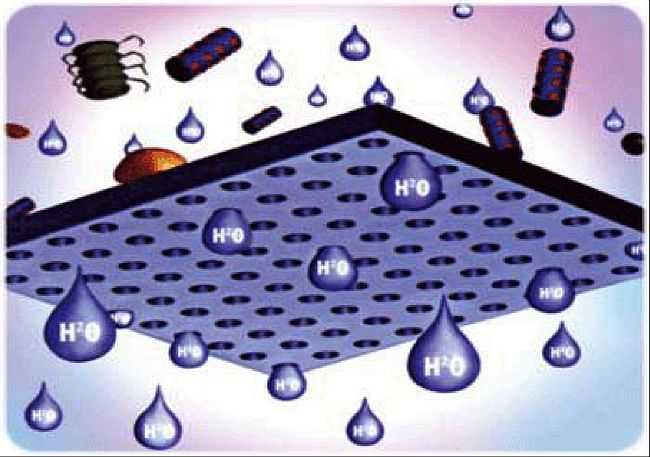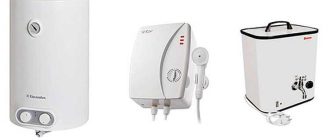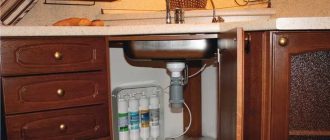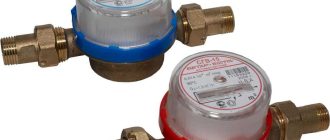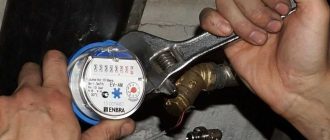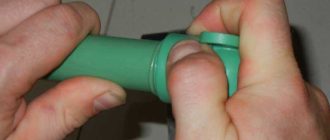The liquid flowing in the centralized water supply system can only conditionally be considered suitable for technical purposes – washing, dishwashing, etc. With great difficulty it can be used for cooking, and it is impossible to drink it without boiling. To bring water to the norm, it is necessary to apply different types of filters. There are inexpensive installations, but they are usually characterized by low performance and average quality of purification, and there are expensive systems that can give ideal results.
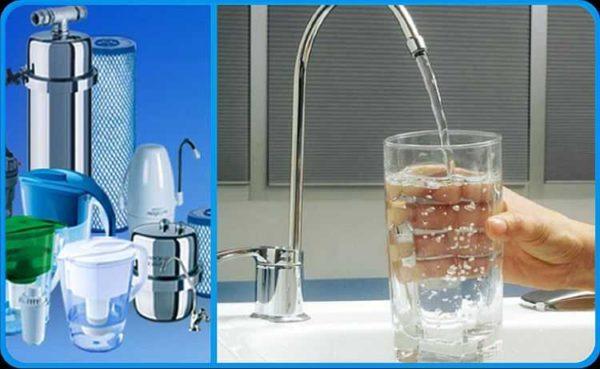
No better is the case with water supply from a well or borehole. There is still a high probability of bacterial contamination, so the purification should be even better. In general, it is necessary to take the sample to analyze, and then, according to the results, select the required types of filters. In private homes, it is usually a multi-stage system, which as a result gives water of drinking quality.
Contenu de l'article
Coarse filters
The most common type, widely used in the home and in production. The water that flows in the water supply contains grains of sand, fragments of rust, metal, scum, etc. These impurities are called mechanical impurities. Their presence has a bad effect on the durability of stop valves (taps, valves, etc.). Therefore, in apartments and private houses at the entrance put filters for their removal. Types of filters for water purification from mechanical impurities are few. Usually it is with a mesh or disk as a filtering element.
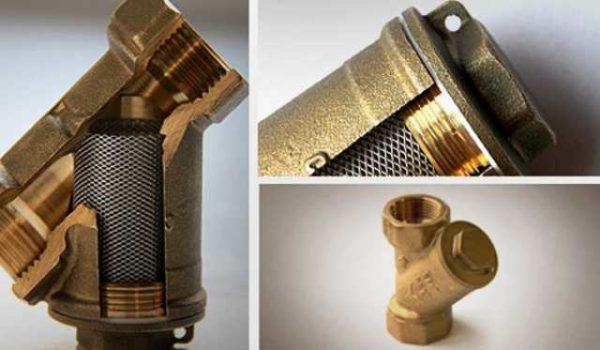
The filter element in mechanical filters is a mesh. According to the size of the cell, these filters are divided into devices of coarse (300-500 microns) and fine purification (coarser than 100 microns). They can stand as a cascade – first coarse cleaning (mud filter), then fine. Often the coarse filter is placed at the inlet to the pipeline, and devices with a finer cell are put in front of the household appliance, as different appliances may require different degrees of water purification.
According to the orientation of the bulb in which the filter element is installed, they are straight and oblique. Oblique create less hydraulic resistance, because this type is installed most often. When installing it is necessary to observe the direction of flow, it is indicated on the body with an arrow.
Mechanical filter
There are two types of mechanical filters – with autoflushing and without. Devices without autoflushing are small in size, their inlet/outlet diameters are selected according to the size of the pipe in which they are installed. The body material is stainless steel or brass, threaded connections are different, external or internal threads are selected as required. The cost of this type of mechanical filters is low, although branded ones can cost much more.

Since the nets are clogged and they periodically need to be cleaned, the lower part of the bulb is removable. If necessary, it is unscrewed and the mesh is washed. All work is carried out beforehand by shutting off the water.
Mesh with autoflushing
Mechanical filter with auto-flushing (self-flushing) has a spigot and a faucet in the lower part of the flask with a filter element. The spigot is connected to the sewer with a hose or a piece of pipe. If it is necessary to rinse the filter open the faucet and the water under pressure washes the contents into the sewer.
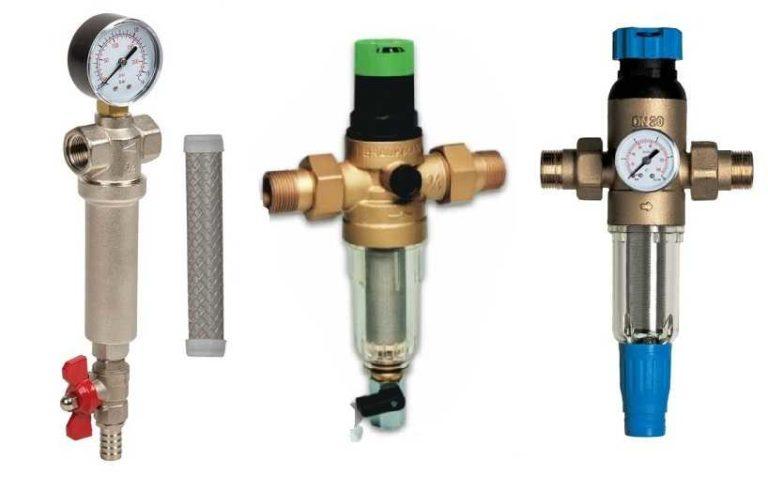
This type of coarse filter may contain a pressure gauge. According to it, it is determined whether the mesh is clogged or not. If the pressure at the outlet has become lower than at the inlet – it’s time to clean the filter. In case of a transparent bulb, there may be no pressure gauge – contamination is determined by the appearance of the mesh or bulb walls. In this segment, oblique water filters are rare, but still occur.
The housing can be built into the reduction valve to neutralize pressure drops. There are models with the possibility of installing an autoflushing unit.
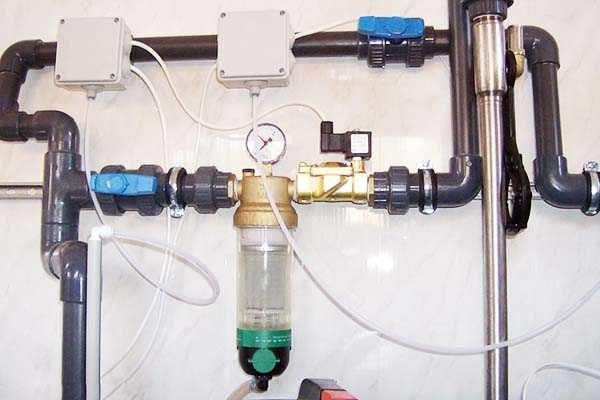
The strapping of this type of mechanical filters is a little more complicated – you need a conclusion to the sewer, but there are also models with different types of threads, so that you can use as few adapters as possible.
Connection types
Mechanical purification filters can be coupling or flanged. Flanged are usually equipped with main water pipelines with large pressures and diameters. But can be used in the arrangement of water supply of a private house.
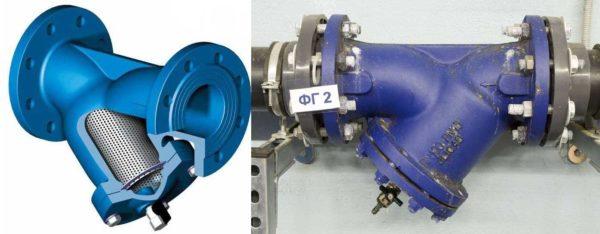
Disk filters
This type of equipment is less common, although less prone to siltation, has a large filtration area, can hold different-sized particles.
Filtering element is a set of polymer disks, on the surface of which there are grooves-scratches of different depth. The disks in the assembled state are tightly pressed against each other, the water passes through the hollows in the disks, and particles of larger diameter settle on them. The movement of water is spiral, so that suspended solids are removed qualitatively.

When the water filter becomes clogged, the disks are taken out of the housing, pulled apart and washed. Periodically, the disks need to be replaced. The service life of the filter element depends on the amount of contamination and the quality of the disks themselves. There are models with auto-flushing.
They are mounted in the pipe break, the bulb can be directed upward or downward, this is indicated in the installation instructions.
Inexpensive types of filters with water purification to drinking water
Purified from mechanical impurities, water can be used for household needs, for example, fed into household appliances. But it is suitable for drinking only conditionally – after boiling. To make it drinkable without boiling, you need fine filters that retain a significant part of the dissolved substances in the water and sanitize it. Consider how to make tap water potable and the types of filters that can be used in this case.
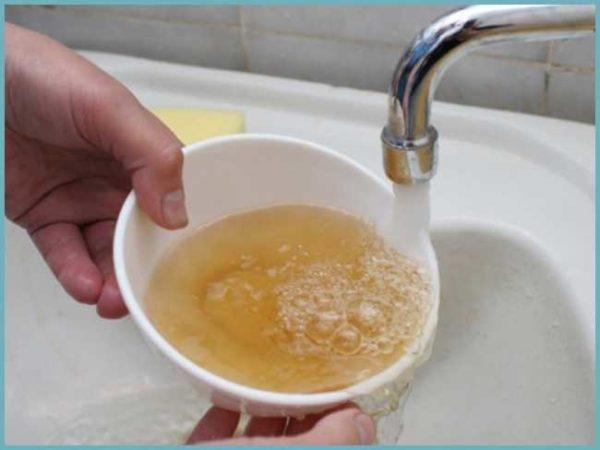
Filter-jug
The simplest, but not very productive way to make tap water potable is to pass it through a filter jug. Purification takes place in a replaceable cartridge through which the water passes. A good cartridge contains the following filtering agents:
- polypropylene fibers to precipitate residual mechanical impurities;
- activated carbon with additives to remove microorganisms and chlorine compounds;
- ion exchange resin for removal of manganese and calcium salts, radionuclides, iron compounds, heavy metals;
- porous activated carbon for water clarification, precipitation of organics.
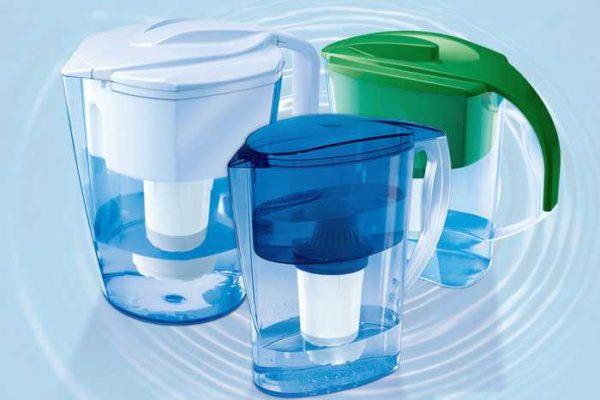
Filters-jug filters are differentiated by the composition of the cartridge, its resource (how much water can purify) and volume. The smallest models of desktop filters can clean 1.5-1.6 liters of water at a time, the largest – about 4 liters. Just keep in mind that in the column “volume of the filter” indicates the volume of the bowl, the useful volume is much smaller – about twice.
| Nom | Bowl volume | Module de nettoyage | Degré de nettoyage | Dispositifs supplémentaires | Prix |
|---|---|---|---|---|---|
| AQUAFOR Art "L'âge de glace | 3,8 litres | 300 л | Réduit la dureté de l'eau, élimine les impuretés mécaniques et organiques, le chlore actif et les métaux lourds. | 4-6$ | |
| AQUAFOR Prestige | 2,8 л | 300 л | Réduit légèrement la dureté de l'eau, élimine les impuretés mécaniques et organiques, le chlore actif et les métaux lourds. | Indicateur de ressources | 5-6$ |
| AQUAFOR Premium "Dachny | 3,8 л | 300 л | Réduit la dureté de l'eau, élimine les impuretés mécaniques et organiques, le chlore actif et les métaux lourds. | Grand entonnoir - 1,7 litre | 8-10$ |
| Pichet filtrant Barrière Extra | 2,5 л | 350 л | Selon le type de filtre | Cassettes pour les différents types d'eau qu'elles contiennent + au coût du pichet | 5-6$ |
| Filtre-jauge Barrière Grand Neo | 4,2 л | 350 л | Selon le type de filtre | Cassettes pour les différents types d'eau qu'elles contiennent + au coût du pichet | 8-10$ |
| Filtre-jug Barrière Smart | 3,3 л | 350 л | Selon le type de filtre | Cassettes pour les différents types d'eau qu'elles contiennent + au coût + indicateur mécanique de la ressource | 9-11$ |
| Filtre-jug Geyser Aquarius | 3,7 л | 300 л | Pour l'eau dure avec traitement bactérien | Indicateur de remplacement de la cartouche | 9-11$ |
| Pichet filtrant Geyser Hercules | 4 л | 300 л | Métaux lourds, fer, composés organiques, chlore | Entonnoir de réception 2 l | 7-10$ |
Faucet filter attachment
Un filtre très compact pour l'eau courante qui se glisse sur le robinet. Taux de purification de 200 ml/min à 6 litres/min. Le degré de purification dépend de la composition de la partie filtrante, mais ne diffère généralement pas beaucoup des filtres à carafe.
Selon le mode de fonctionnement, il existe deux types de filtres sur le robinet : certains sont mis en place immédiatement avant l'utilisation, d'autres ont la possibilité de passer en mode "pas de nettoyage". La seconde option est évidemment plus pratique, mais les interrupteurs se cassent souvent. En tant que mesure temporaire, c'est une excellente solution, mais en tant que mesure "permanente", il est préférable de choisir un autre dispositif.
| Nom | Performance | Ressources de la cassette | Ce qu'il nettoie | Pays de fabrication | Prix |
|---|---|---|---|---|---|
| Defort DWF-600 | jusqu'à 20 l/h | 3000-5000 л | Substances organiques, pesticides, métaux lourds, chlore et éléments radioactifs | Chine | 2$ |
| Defort DWF-500 | jusqu'à 20 l/h | 3000-5000 litres ou 6 mois | Substances organiques, pesticides, métaux lourds, chlore et éléments radioactifs | Chine | 2$ |
| Aquaphor Modern-1 | 1-1,2 l/min | 40000 л | du chlore actif, du plomb, du cadmium, des phénols, des benzènes, des pesticides | Russie | 13-15$ |
| Aquaphor "V300" avec post-traitement bactérien | 0,3 l/min | 1000 л | recommandé en cas de contamination bactérienne possible de l'eau | Russie | 4-5$ |
| Geyser Euro | 0,5 l/min | 3000 л | Composés cancérigènes et organiques, chlore, fer, métaux lourds, nitrates, pesticides et micro-organismes | Russie | 13-15$ |
| Philips WP-3861 | 2 l/min | 2000 л | composés du chlore | 180$ | |
| Sorbant RODNIK-ZM | 2 l/min | 3600 л | nettoyage du chlore libre, défertilisation | 8-10$ |
Filters under the sink
Pour une purification de l'eau plus performante et de meilleure qualité, utilisez des filtres installés sous ou sur l'évier avec un montage mural.
Il existe deux types de systèmes : les systèmes à cartouche et les systèmes à osmose inverse. Les cartouches sont moins chères, et c'est là leur avantage, mais leur inconvénient est qu'il faut surveiller l'état de l'élément filtrant et le changer à temps, sinon toute la saleté accumulée passe dans l'eau.
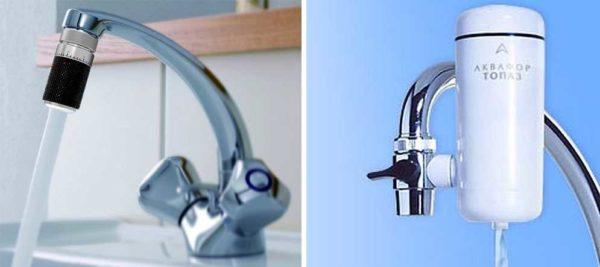
Systèmes d'osmose inverse - il s'agit déjà d'un équipement plus technologique, dont le coût est beaucoup plus élevé, mais dont la qualité de purification et la productivité sont bien supérieures. Ces unités de purification de l'eau utilisent une membrane multicouche, dont chaque couche retient les contaminants d'un certain type.
Cartouche
Dans les filtres à cartouche, la qualité de la purification dépend du nombre d'étapes de purification, c'est-à-dire d'éléments filtrants individuels qui "capturent" un certain type de contaminants. Il existe des systèmes à un étage, des filtres à deux, trois et même quatre étages.
Dans les épurateurs à un étage, on utilise des inserts universels à structure multicouche. Ils sont peu coûteux, mais il est difficile de prédire si vous serez satisfait du degré de purification. La composition de l'eau est très différente d'une région à l'autre et il serait souhaitable de sélectionner les filtres en fonction de la composition de l'eau.
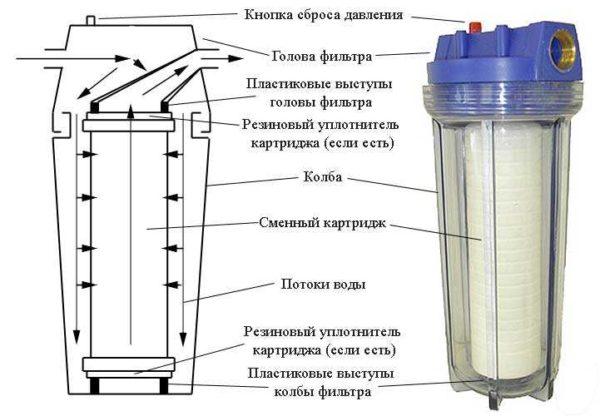
Dans les filtres à cartouche à plusieurs étages, le corps est constitué de plusieurs flacons, chacun d'entre eux étant doté d'un élément filtrant distinct qui élimine certains contaminants. Les flacons sont reliés en série au moyen de trop-pleins, et l'eau est purifiée en passant d'un flacon à l'autre. Dans ce cas, il est possible de sélectionner les types de filtres spécifiques à votre analyse, ce qui améliorera sans aucun doute la qualité de la purification.
| Nom du filtre à cartouche | Type | Nombre d'étapes de purification | Pour quel type d'eau | Ressources en cartouches | Performance | Prix |
|---|---|---|---|---|---|---|
| BWT Woda-Pure | Domestique avec option de rinçage | 1 cartouche + membrane | dureté moyenne | 10 000 litres ou 6 mois | 1,5-3 l/min | 70$ |
| Raifil PU897 BK1 PR (Grand Bleu 10″) | Malle | 1 | eau froide du robinet | 26$ | ||
| Geyser Lux | Sous l'évier | 3 | souple/moyen/dur/dur/fer | 7000 л | 3 l/min | 70-85$ |
| GEYSER GEYSER-3 BIO | Sous l'évier | 3 + protection contre les virus et les bactéries | doux/dur/très dur/ironique | 7000 л | 3 l/min | 110-125$ |
| Geyser-1 Euro | Version de table | 1 | normal/doux/dur | 7000 л | 1,5 l/min | 32-35$ |
| Pentek Slim Line 10 | Malle | 1 | 19 l/min | 20$ | ||
| Expert M200 | Sous l'évier | 3 | normal/soft | 6,000 – 10,000 liters depending on cartridge | 1-2 l/min | 60-65$ |
| Brita On Line Active Plus | Sous l'évier | 1 | flowing | 2 l/min | 80-85$ | |
| AQUAFILTER FP3-HJ-K1 | Sous l'évier | 4 + protection against bacteria and viruses | for cold water | 3 l/min | 60-90$ | |
| Barrier Expert Hard | Sous l'évier | 3 | for hard water | 10,000 liters or 1 year | 2 l/min | 55-60 $ |
| Atoll D-31 (Patriot) | Sous l'évier | 3 | highly chlorinated water | 3,8 l/min | 67$ |
Tabletop cartridge filters for running water
The most inexpensive version of cartridge filters is installed next to the sink and are characterized by small dimensions. Can be one or two-stage, on the body there is a small-sized faucet. The filter is connected by hoses to a special faucet outlet or directly to the water supply.
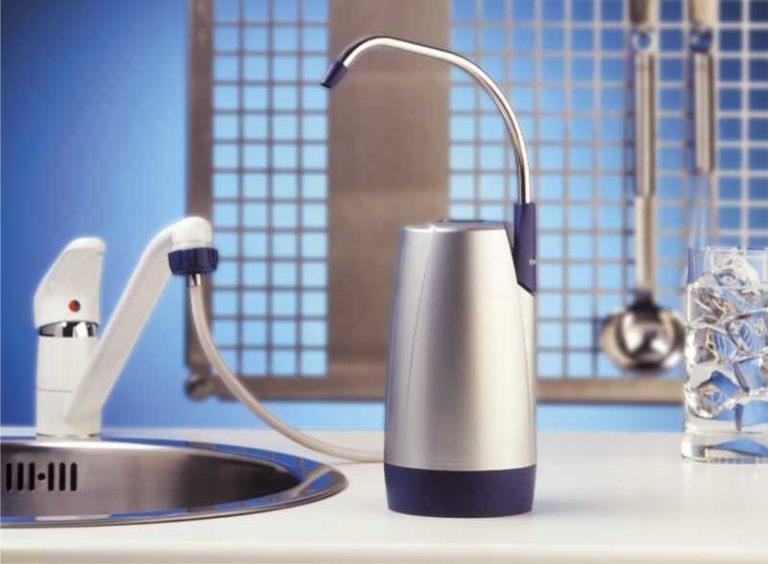
Trunk filters
These are usually cartridge single-stage filters-columns, which are placed after the mechanical filter. They remove a significant amount of impurities, making water suitable for drinking and protecting household appliances from the formation of scale and other deposits. Their disadvantage is the need to change filter elements.
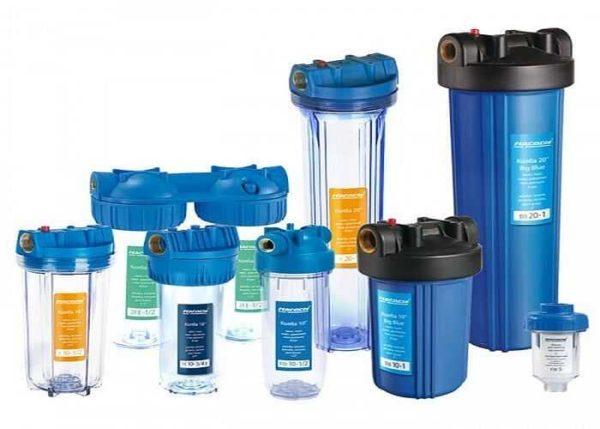
For the convenience of tracking the state and degree of contamination, the bulb is made transparent. In case of severe contamination, it is necessary to replace the cartridge with another. In some models, it is possible to restore the performance of the cleaning element after rinsing it under running water. In other models it is forbidden to do this, so carefully read the instructions.
Multistage filters
From those described above differ in the large number of flasks, each of which has a cartridge that removes different types of contaminants. The more stages of purification, the cleaner the water is at the output. Select the composition of filter elements should be selected for a particular composition of water.
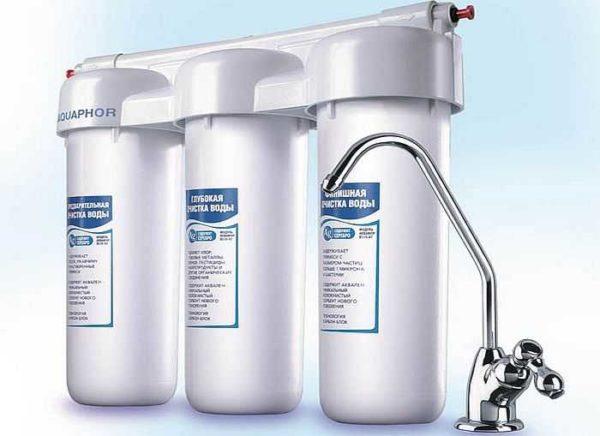
These systems can be placed under the sink and give high quality drinking water.
Reverse osmosis
The most advanced water purification technology today is reverse osmosis. The system uses multi-layer membranes that allow only water and oxygen molecules to pass through, without allowing small contaminants to pass through. The resulting water is virtually salt-free, which is not good either. This is the main disadvantage of reverse osmosis systems. To neutralize it in the installations are equipped with mineralizers, which add the necessary minerals.
| Nom | Nombre d'étapes de purification | Replacement life/frequency | Filtration rate | Notes | Prix |
|---|---|---|---|---|---|
| Geyser Prestige 2 | 6 | 1 time per year | 0.15 l/min | Purified water storage tank 7.6 liters | 70-85$ |
| Atoll A-450 (Patriot) | 6 | prefilters – 6 months, membrane -24-30 months, carbon postfilter – 6 months. | 120 l / day | There is an external tank | 115-130$ |
| Barrier Profi Osmo 100 | 6 | 1 stage – from 3 to 6 months, 2 stages – every 5 – 6 months, 3 stages – from 3 to 6 months, 4 stages – from 12 to 18 months (up to 5000 liters), 5 stages – every 12 months. | 12 liters/hour | There is an external tank | 95-120$ |
| Aquaphor DWM 101S Morion (with mineralizer) | 6 | prefilters – 3-4 months, membrane – 18-24 months, postfilter-mineralizer – 12 months. | 7,8 l/hour | External tank + mineralizer | 120-135$ |
| Barrier K-OSMOS (K-OSMOS) | 4 | 5000 liters (not more than a year) | 200 l / day | External tank | 120-150$ |
| Atoll A-450 STD Compact | 5 | prefilters – 6 months, membrane – 24-30 months, carbon postfilter – 6 months. | 120 l / day | External tank | 150$ |
The disadvantages of this system include their low productivity – in a minute can run up only one glass or so of clean water. It is clear that this speed is an inconvenience, so that it was felt less, manufacturers complete the installation with tanks for purified water, to which are already connected to the faucets.
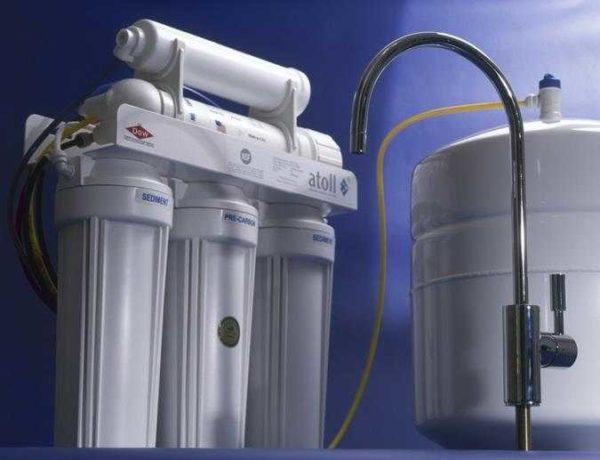
Filters for purifying water from dissolved substances
In addition to mechanical impurities in tap water is a decent part of the Mendeleev table: iron, mercury, manganese, potassium, calcium (hardness salts from which the scale is formed), etc. They can be removed, but different filters are needed for this purpose.
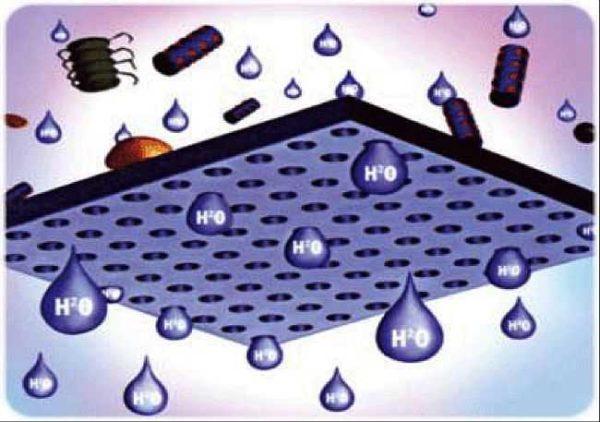
To remove iron
Most often in water from wells or boreholes there is a lot of iron. It gives the water a reddish tint and a specific taste, deposits on the walls of sanitary appliances, clogs the stop valves. It makes sense to do this if the amount of iron exceeds 2 mg/l.
Dissolved in the water divalent iron can be removed from the water with the help of a catalytic filter. This is a large cylinder into which catalysts are poured, the work is controlled by a small processor, that is, this equipment requires power supply.

The backfill in the catalytic filter accelerates the oxidation of divalent iron and its precipitation many times over. Depending on the backfill, impurities of manganese, chlorine, other dissolved substances in the water can also be removed, and mechanical particles can also settle to the bottom during the purification process. The removal of accumulated sediments takes place according to a set schedule, usually at night. The backfill is washed under water pressure, everything is discharged into the sewer, water supply is stopped for the time of washing. Catalytic filters are complex and inexpensive equipment, but they are the most durable of the existing ones.
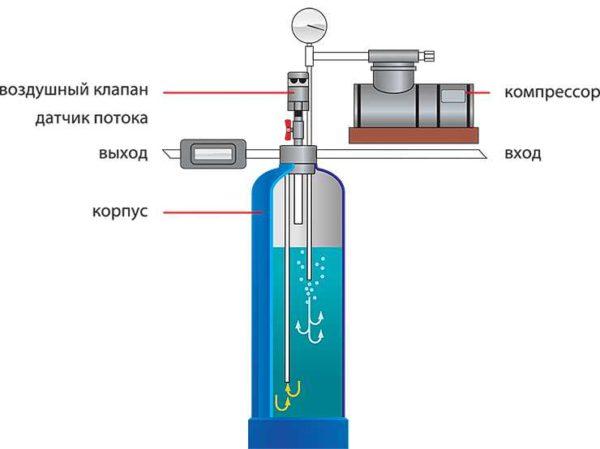
Another way to remove iron and water is aeration. In a cylinder with pumped air, water in the form of a fine suspension is supplied. The iron in it reacts with the oxygen in the air and its oxides are filtered out at the outlet. There are two types of aeration filters – pressurized and non-pressurized. For more active oxidation, an oxidizing agent such as hydrogen peroxide or sodium hypochlorite can be fed into these units. In this case, there is also biological purification of water from microbes and bacteria.
Read more about purification of water from the well and well here.
Water purification from hardness salts
To soften water, filters with ion exchange resins are used. In the process of interaction with water, harmful impurities are replaced by neutral or useful (increase in the amount of iodine and fluorine).
Externally, this equipment is a tank partially filled with ion exchange material. It is paired with a second similar regenerator tank filled with a highly concentrated salt solution. It is sold in special tablets with a high degree of purification.
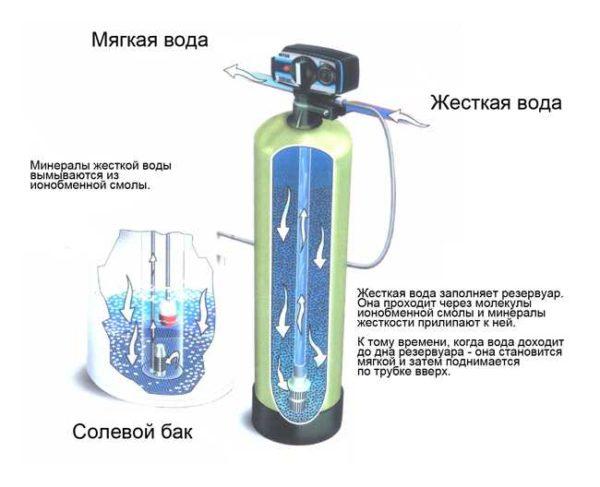
The advantages of this type of installations – high performance, low noise level during operation and rare replacement of the backfill, it is enough for 5-7 years. For water softening ion exchange filters are the best choice. Minuses in the need to use a regeneration tank with a concentrated salt solution. To get potable water, you need to put a filter with activated carbon.


